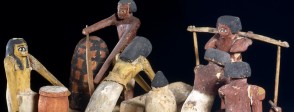Show the class the image of the tomb model and explain that it shows two food production processes: making beer and butchery. Men and women are distinguished by the colour of their skin – the men are brown, the women yellow. The brewing process is not straightforward to identify so give them this list of things to find and suggest they label the picture:
• an oven with a rounded top to part-bake the dough
• a woman leaning forward to grind grain into flour
• a man carrying jars of water on a pole across his shoulders
• a dead cow
• a man with a knife who will cut up the cow
• a jar of beer with a black lid
• a woman mixing dough and water in a jar with white foam on top
Explain the processes in more detail. Why do they think a model like this would be placed in a tomb?
Look at the painting of food offerings in For the classroom and discuss what is happening in it. Ask the students to look for:
• spring onions
• round loaves of bread
• a basket of figs
• joints of meat
• pomegranates
• cucumbers
• grapes
• small cakes
• duck
• a basket of berries
Which foods do students think should be cooked before eating? Which are better eaten raw? Is this a healthy meal? Would they enjoy it?
Look at the paintings from Nebamun’s tomb in For the classroom. Ask students to describe what is happening in each one. How many different types of foodstuffs can they identify in each painting? Explain who Nebamun was and what he did. Why do the class think he had these scenes painted in his tomb? What do they tell us about his life?
Cut out pictures of different kinds of foods from magazines, or print some out. Include foods that would have been familiar to the ancient Egyptians, such as kebabs, lentils, grapes, feta cheese, plain yoghurt, hummus, falafels, and those unknown to them such as chocolate, ice cream, tomatoes, chips, rice, oranges. Give the pictures to groups of students and ask them to identify which foods the Egyptians would have known. Do some research to find out why they would not have known the others.
Use the images in A bigger picture to explore Egyptian farming. Discuss what each shows and how objects were used. You could examine the stages of growing grain: preparing the fields, sowing, irrigating and feeding crops, weeding and keeping pests away, harvesting, processing and storing grain. Add the model of baking and the loaf of bread in For the classroom and print out all the objects. Mix them up and ask students to put them in sequence from preparing the fields to the loaf of bread.
Explain how the Nile flood shaped the Egyptian year and determined the way food was grown. How does this compare with modern arable farming? Topics could include comparing tractors and threshing machines with draught animals or chemical fertilizers with Nile silt. Would a modern farmer recognize Egyptian farming equipment?
Working in groups, ask students to research ancient and modern agriculture and imagine a conversation between an ancient Egyptian farmer and a modern farmer. What would they have in common? What would be different? Could they offer each other any advice? This activity could lead to a class play or presentation. Alternatively, individual students could write an account of a modern farmer visiting ancient Egypt or an ancient Egyptian farmer visiting a modern farm.
Show the class images of Egyptian offering scenes from tomb paintings and models. What would a modern offering table look like? Ask individual students to think about their favourite foods and drinks and draw their own offering scene or create one as a class project.
Plan an Egyptian buffet with the class. What foods and drinks should you have? If you have access to an oven or hob, students can cook the bread themselves.
Many cultures have bread as a staple food, with thousands of different recipes found around the world. How many different types of bread can the class think of? Ask students to find out about the kind of the bread they eat at home. What is it made from? How is it prepared? What kind of oven is it cooked in? If appropriate, invite them to bring a sample in to share with the class.
Use Nebamun’s paintings of officials counting poultry and cattle as the starting point for simple mathematical problems, such as counting the free geese and caged ones separately and adding the sums together, or counting the cattle and subtracting the number of people in the scene. The painting of officials measuring field boundaries could also be used to introduce problems involving the calculation of area.


